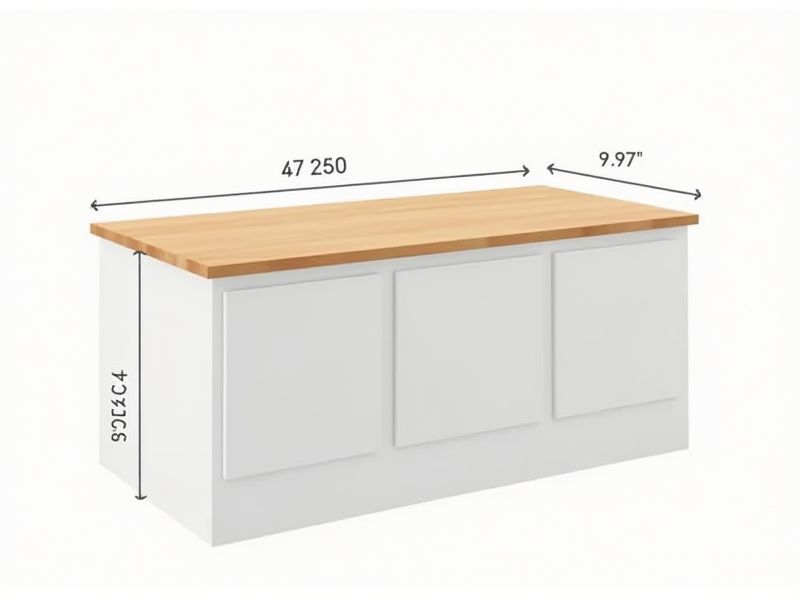
The standard dimensions for a kitchen countertop typically feature a depth of 24 inches (61 cm), which fits most base cabinets. The standard height is generally 36 inches (91 cm) from the floor to the top of the counter, providing comfortable workspace for most users. Length can vary depending on the kitchen's design, but countertops are often installed in sections ranging from 4 to 10 feet. Most countertops also include a backsplash, usually 4 inches (10 cm) high, to help protect the wall from spills and splashes.
Width
The standard width of kitchen countertops typically measures 25 to 26 inches, ensuring ample workspace for various cooking and preparation tasks. This measurement allows for easy installation over standard kitchen cabinetry, which usually have a depth of 24 inches. When designing your kitchen, it's essential to consider the size of your appliances and layout, as a wider countertop can enhance functionality and improve flow. Additionally, you might explore custom options if your kitchen requires unique dimensions or features to optimize usability.
Depth
The standard depth for kitchen countertops typically ranges from 25 to 26 inches, providing ample space for various kitchen activities. This depth allows for comfortable usage while also accommodating standard upper cabinet heights and ensuring maximized storage efficiency. With a standard depth of 2 to 3 inches for countertops, including materials like granite, quartz, and laminate, you can achieve a balanced aesthetic and practical functionality. Ensuring your kitchen design adheres to these depth standards will enhance both usability and visual appeal in your home.
Height
The standard height for kitchen countertops typically ranges from 34 to 36 inches (86 to 91 centimeters), accommodating the average user's comfort while cooking and preparing food. Bar-height countertops usually stand at about 42 inches (107 centimeters), offering a more casual dining experience. For individuals with specific needs, adjustable countertop heights can enhance accessibility, particularly for wheelchair users, with some designs allowing for heights as low as 28 inches (71 centimeters). When designing or renovating your kitchen, considering these standard heights can greatly improve functionality and user experience.
Overhang
An ideal kitchen countertop overhang typically measures between 1 to 1.5 inches for standard countertops, providing a blend of aesthetics and functionality. Overhangs can extend up to 12 inches for bar seating areas, accommodating both comfort and movement. For a seamless transition between the kitchen and dining, consider an overhang supported by properly designed brackets that can sustain weight effectively. Remember, a well-planned overhang not only enhances visual appeal but also maximizes usable counter space.
Thickness
The standard thickness of kitchen countertops typically ranges from 1.5 to 3 centimeters (0.6 to 1.2 inches), with 2 centimeters being the most common choice for many homeowners. A thicker countertop, such as 3 centimeters, not only offers enhanced durability but also creates a more substantial visual presence in the kitchen. When selecting the thickness, consider the material; for example, granite and quartz are often available in various thicknesses, while laminate usually comes in thinner options. Choosing the right countertop thickness can significantly impact both the functionality and aesthetic appeal of your kitchen space.
Material
The standard for kitchen countertops emphasizes durability and aesthetics, with popular materials including granite, quartz, and marble. Granite, known for its heat resistance and unique patterns, typically ranges from $40 to $200 per square foot, making it both a luxurious and sturdy option. Quartz, an engineered stone, offers a non-porous surface, ideal for those seeking low maintenance, usually priced between $50 and $150 per square foot. Marble, celebrated for its elegance and veining, comes at a higher cost of $60 to $200 per square foot, requiring regular sealing to maintain its appearance.
Edge Profile
Choosing the right edge profile for your kitchen countertop can significantly enhance its aesthetic and functional appeal. Popular edge profiles include the classic eased edge, which offers a smooth finish, and the more pronounced bullnose edge, ideal for families due to its safety features. For a modern look, consider a waterfall edge that allows the countertop material to flow seamlessly down the sides, creating a stunning visual impact. You should also factor in the countertop material; for instance, quartz or granite allows for intricate edge designs, while laminate typically favors simpler profiles.
Cabinet Compatibility
When selecting kitchen countertops, ensuring compatibility with your cabinets is crucial for a cohesive and functional design. Most kitchen cabinets are built to accommodate standard countertop depths of 25 to 26 inches, while heights typically range from 34.5 to 36 inches. Materials like granite, quartz, and laminate are popular choices, with granite offering a robust lifespan of 15 to 30 years, depending on care. By aligning your countertop choice with your cabinet style and color, you can elevate your kitchen's aesthetic and functionality.
Backsplash Height
The standard backsplash height for kitchen countertops typically ranges from 4 to 6 inches above the countertop surface. For more contemporary designs, a full-height backsplash, extending from the countertop to the bottom of the upper cabinets, is increasingly popular, often measuring 18 inches or more. Choosing a backsplash material that complements your countertop can enhance the overall aesthetic; common materials include ceramic tile, glass, and natural stone. Ensuring your backsplash is at a standard height not only protects your walls from water damage but also creates a cohesive look for your kitchen design.
Seam Placement
When selecting a kitchen countertop, the standard for seam placement is critical for both aesthetic appeal and structural integrity. Ideally, seams should be located away from high-traffic areas and not directly in front of the sink or cooktop, which helps to minimize visibility and enhance functionality. For materials like granite or quartz, a seam should typically be no wider than 1/16 inch, ensuring a smooth transition between sections. If you're considering a solid surface, look for a fabricator who employs advanced techniques to create nearly invisible seams, elevating the overall elegance of your kitchen design.
